The Chilean Puyas
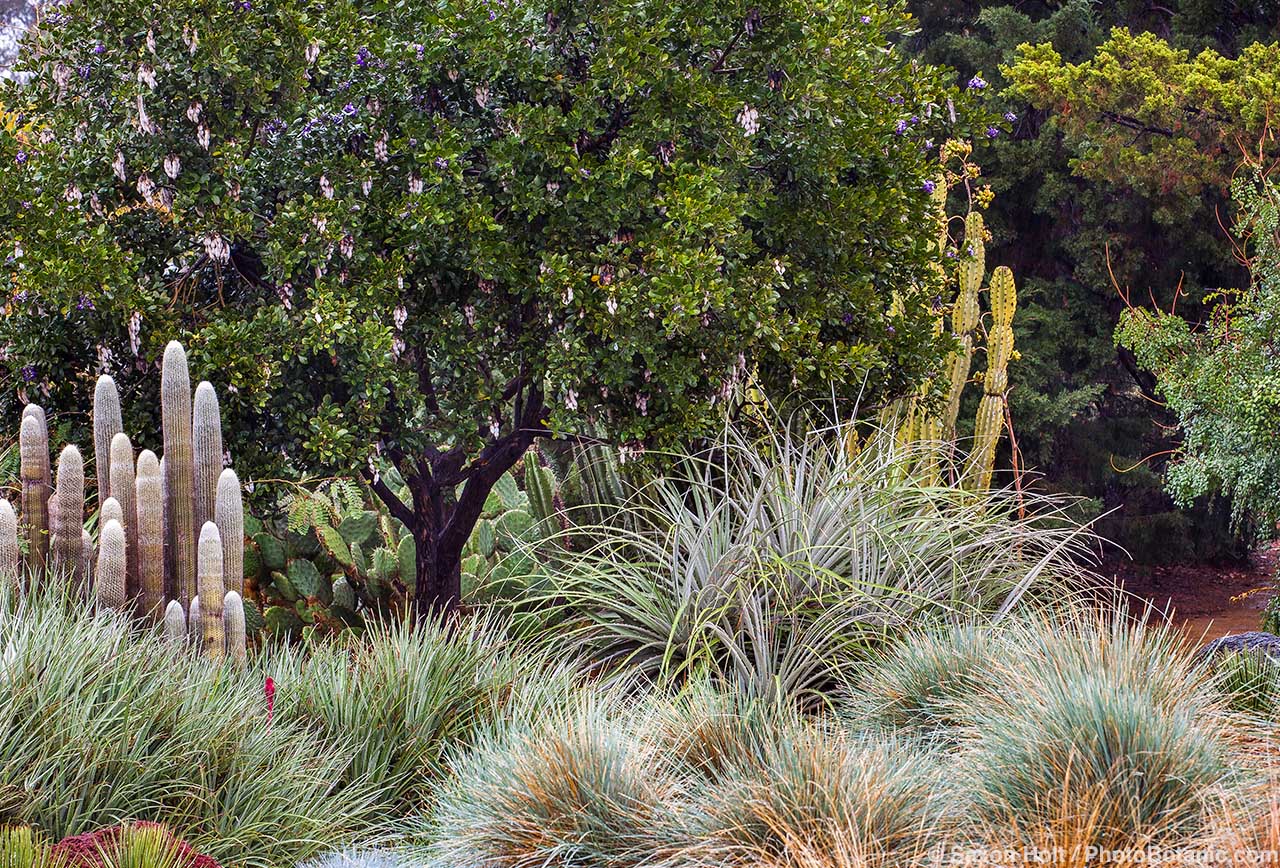
Share This!
Puyas (Puya species) are evergreen terrestrial bromeliads and typically are described as native to the Andes Mountains of South America and for the most part this is true. Almost all of the 200-plus species of spiny-leaved, rosette-forming puyas are found in moist to dry habitats at mid- to high elevations of the South American Andes.
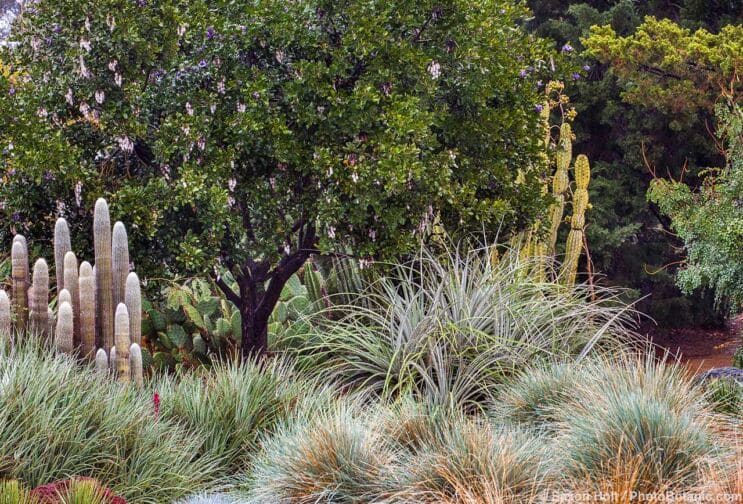
Puyas blend well with the textures and colors of many other summer-dry plants.
Two puyas are native to the wet mountains of Costa Rica and the distribution of several others extends eastward into the rainforests of Brazil. Seven puyas are native primarily to low elevations of central Chile, with a climate described as mediterranean. These seven are geographically isolated from other puyas by some of the highest peaks of the Andes to the east and to the north by the Atacama Desert, one of the driest places in the world.
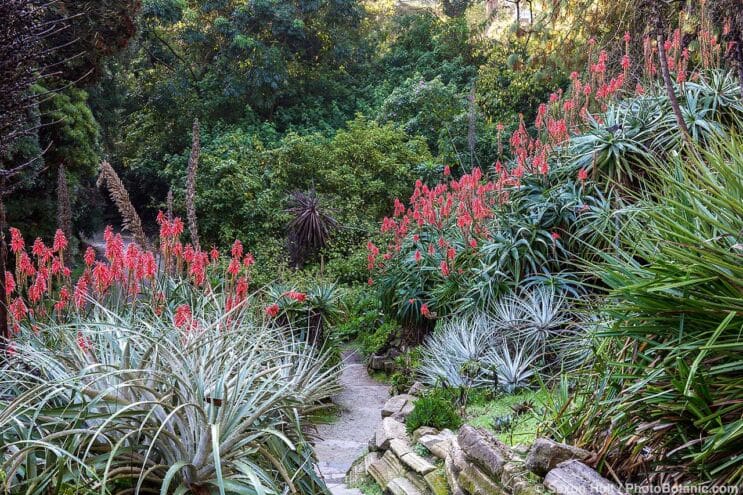
Puyas (foreground) and aloes (flowering) in the San Francisco Botanical Garden
To say that a plant is native to Chile is like saying a plant is native to western North America. With a north-to-south length of a little more than 2,600 miles (and an average width of 112), Chile contains at least five or six different climates. These range from year-round arid in the north to year-round damp to wet in the far south. Only central Chile is reliably summer-dry with mild winter temperatures and slight to moderate rainfall concentrated in winter months.
The Chilean puyas can be divided into three genetically related groups: the greenish blue-flowered, the greenish yellow-flowered, and the purplish blue-flowered. They are also separated into two subgenera based on the sterility (Puya) or fertility (Puyopsis) of the flowers at the tips of the lateral flowering branches.
Subgenus Puya contains the Chilean species with greenish yellow flowers and those with greenish blue flowers. The purplish blue-flowered Chilean species are placed within the subgenus Puyopsis along with almost all of the rest of the puyas of Central and South America.
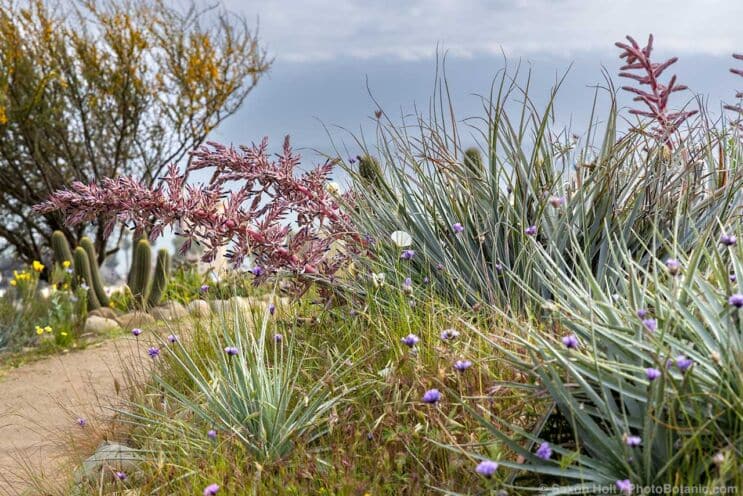
Puya coerulea has purplish blue flowers widely spaced on pinkish red stalks, shown here in the Ventura Botanical Gardens.
This may all seem to be of interest only to the scientifically inclined. The takeaway for gardeners is that the Chilean puyas, unlike many puyas native to other parts of Central and South America, are particularly well suited to low to mid-elevation landscapes in other mild-winter summer-dry climates.
Before seeking them out, gardeners unfamiliar with these plants should be aware that puyas can become fairly large plants with leaf margins that are quite viciously spined and that most will spread slowly by offsets to become impenetrable colonies. Gardeners familiar with cacti and spiny succulents will know best how to grow them successfully.
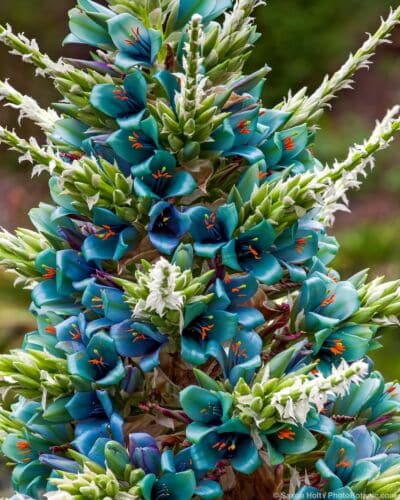
Puya alpestris has metallic greenish blue flowers tightly packed on a tall, broad inflorescence.
Among the greenish blue-flowered species Puya alpestris probably is the best known and most sought after by gardeners. This highly variable plant is native to both arid and semi-humid habitats near the coast and in the Chilean Andes at elevations up to 6,500 feet. Two subspecies are currently recognized: P. alpestris subspecies zoellneri is a larger plant from arid north-central Chile with flowers densely clustered. Subspecies alpestris is smaller, has a southern, more humid distribution, and has flowers more widely spaced.
Puya alpestris forms a dense rosette 2-3 feet tall and 3-6 feet wide. Leaves are green above and whitish below with short, sharp spines along the margins. Waxy, metallic greenish blue flowers with electric orange pollen are clustered on a tall, upright stalk. As with many other puyas, it is slow-growing and it can be many years before it blooms.
Plants offered in the nursery trade as Puya berteroniana or as P. x berteroniana are similar in appearance to P. alpestris but tend to be larger at maturity with longer leaves and flowers on taller stalks. Plants in the trade under these names are now believed to be P. alpestris subspecies zoellneri. P. berteroniana is presumably a rare hybrid (P. x berteroniana) no longer found in the wild and not in cultivation.
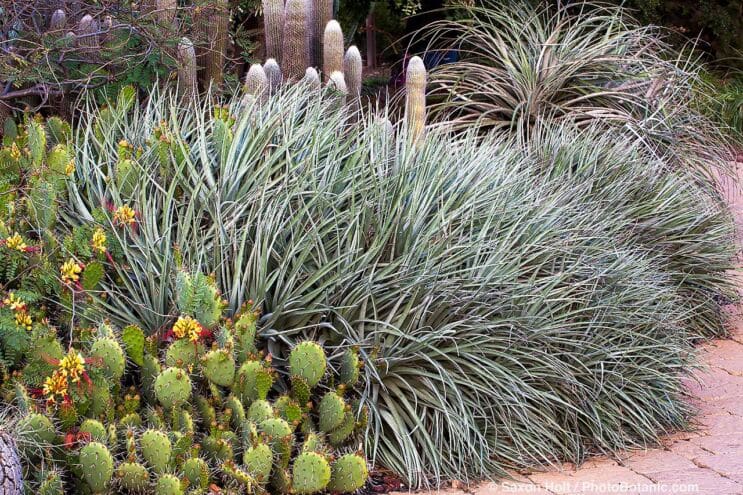
Puya venusta offsets freely, forming dense stands at the Los Angeles County Arboretum.
Puya venusta and P. coerulea have purplish blue flowers. P. venusta bears dark blue to dark violet flowers with yellow pollen on stalks that rise 3 feet above the 3- to 4-foot tall rosettes of silvery gray leaves. This plant slowly forms dense stands in sandy or rocky areas right along the coast and in the coastal mountains of north-central Chile. Individual rosettes can be grown in large containers or in the ground in gardens where their spread can be contained.
Puya coerulea is a highly variable species with four recognized varieties, all of which are vulnerable or near threatened in the wild. Plants have narrow, silvery gray, almost white leaves and pinkish red spikes bearing purple to dark purplish blue, almost black flowers with yellow to orange pollen. P. coerulea is found mostly at low elevations on rocky outcrops in the coastal mountains of central Chile but occasionally occurs in the Andes Mountains or in stony, semi-arid areas in the valleys between the Andes and the coastal mountains.
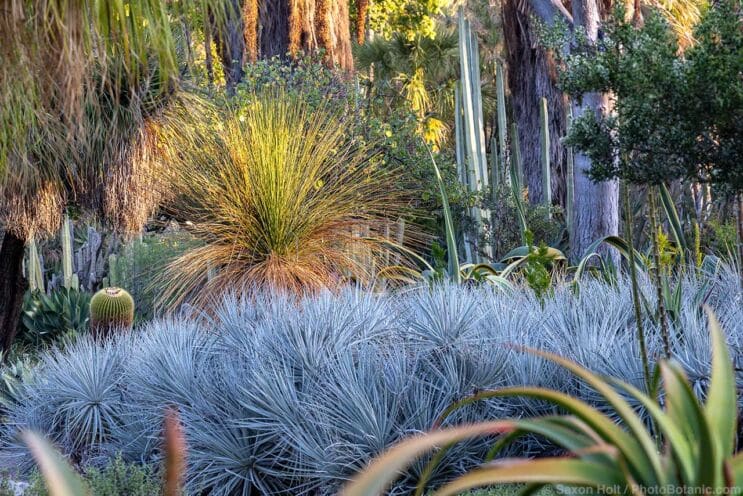
Puya coerulea, commonly known as silver puya, at the Botanical Gardens of the Huntington Library
Three of the Chilean puyas have yellow flowers: Puya chilensis, P. boliviensis, and P. gilmartinae. P. chilensis has chartreuse-yellow flowers with bright orange pollen on stalks that can reach 8-10 feet tall. It is native to slopes near the ocean from as low as 50 feet up to 6,000 feet elevation. This is one of the few puyas with rosettes that bloom repeatedly at maturity, which can take a decade or two.
Puya boliviensis and P. gilmartinae are the only Chilean puyas with a limited distribution. P. boliviensis is a rare and endangered plant that occurs at an isolated location in the southern Atacama Desert, north of the mediterranean zone and a couple hundred miles from the rest of the Chilean puyas. It subsists on moisture provided by coastal fog. P. gilmartinae is critically endangered, narrowly distributed between the ranges of P. chilensis and P. boliviensis at elevations from just above sea level to less than 2,000 feet.
Most of the Chilean puyas are somewhat available in the trade today, either from specialty nurseries or from seed suppliers. In the garden they need full sun except in the hottest climates where, like many succulents (which puyas technically are not), they will need some afternoon shade. Most Chilean puyas are quite tolerant of a little frost if well drained and protected from the coldest winds. They do not survive where winter rains are substantial without near-perfect drainage.
Share This!
6 Comments
Leave A Comment
Related Articles
By: Nora Harlow
By: Saxon Holt
By: Nora Harlow





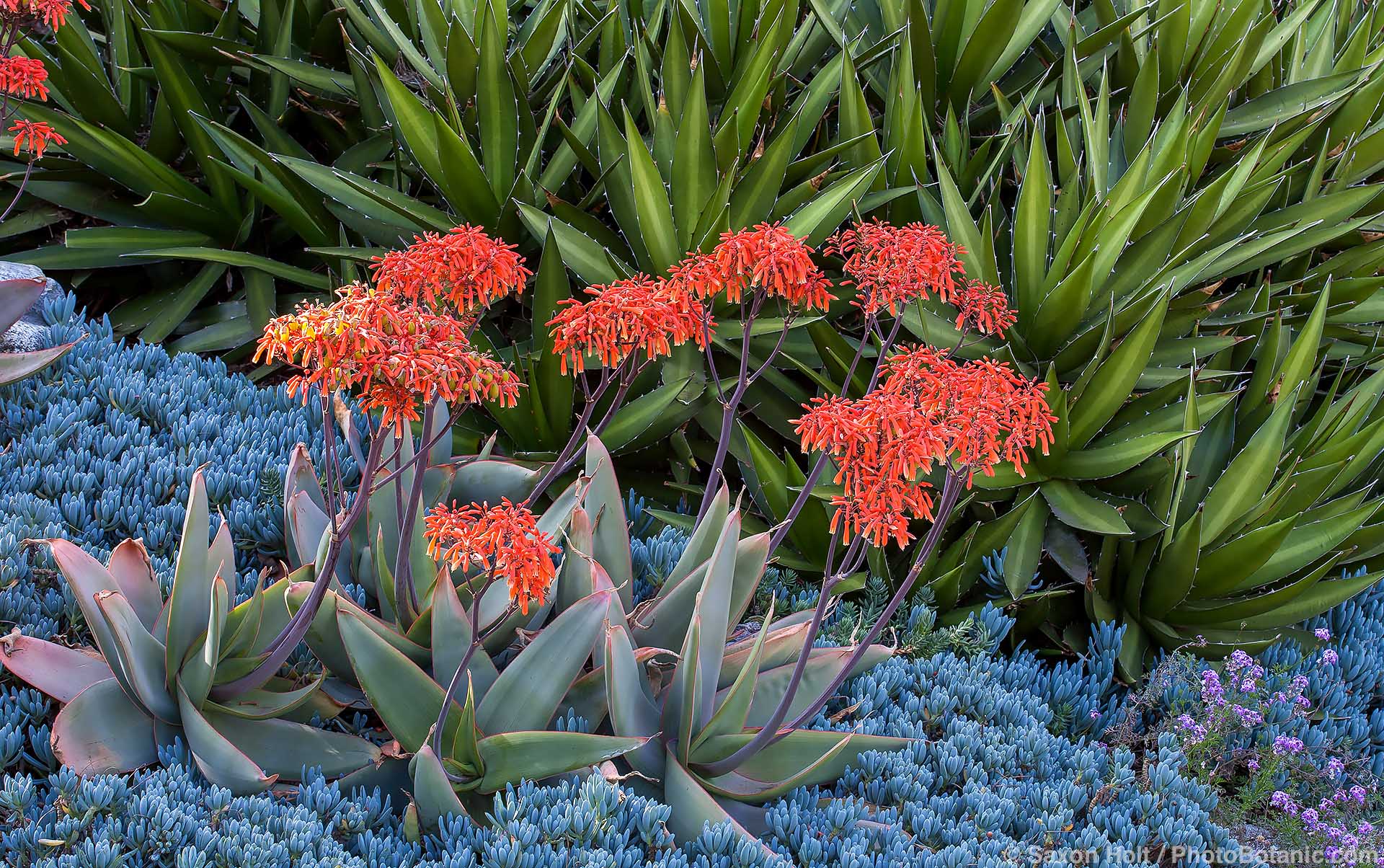
Are Puya hybridized in the nursery trade ?
Interesting question, Jack, but I don’t know. Puyas hybridize readily in the wild where their ranges overlap. I haven’t read anything that suggests that hybrids are offered in the nursery trade. Let us know if you find out.
Nora
My puya, grown at the UCSC arboretum, has the pale, sparse, greenish yellow flowers. This year for some reason, it developed mealy bugs. I cut down all the flowering stalks (most had finished blooming), as that is where the mealy bugs were concentrated. Any recommendations for treatment? Did we have too much water on the Central Coast? (I give it none).
What is the drainage like where it’s planted? How much sun does it get in winter? And which puya is it? It does sound like a water-related problem.
Nora
Just a note of appreciation for the wonderful resource Saxon and Nora are continuing to nurture. I just took some time to read about puyas, feijoas, and Luma apiculata. The writing is fluent, interesting, and informative, and of course the images are enchanting.
Thanks so much Jason. We love to hear from our readers and your comments are much appreciated.
Nora